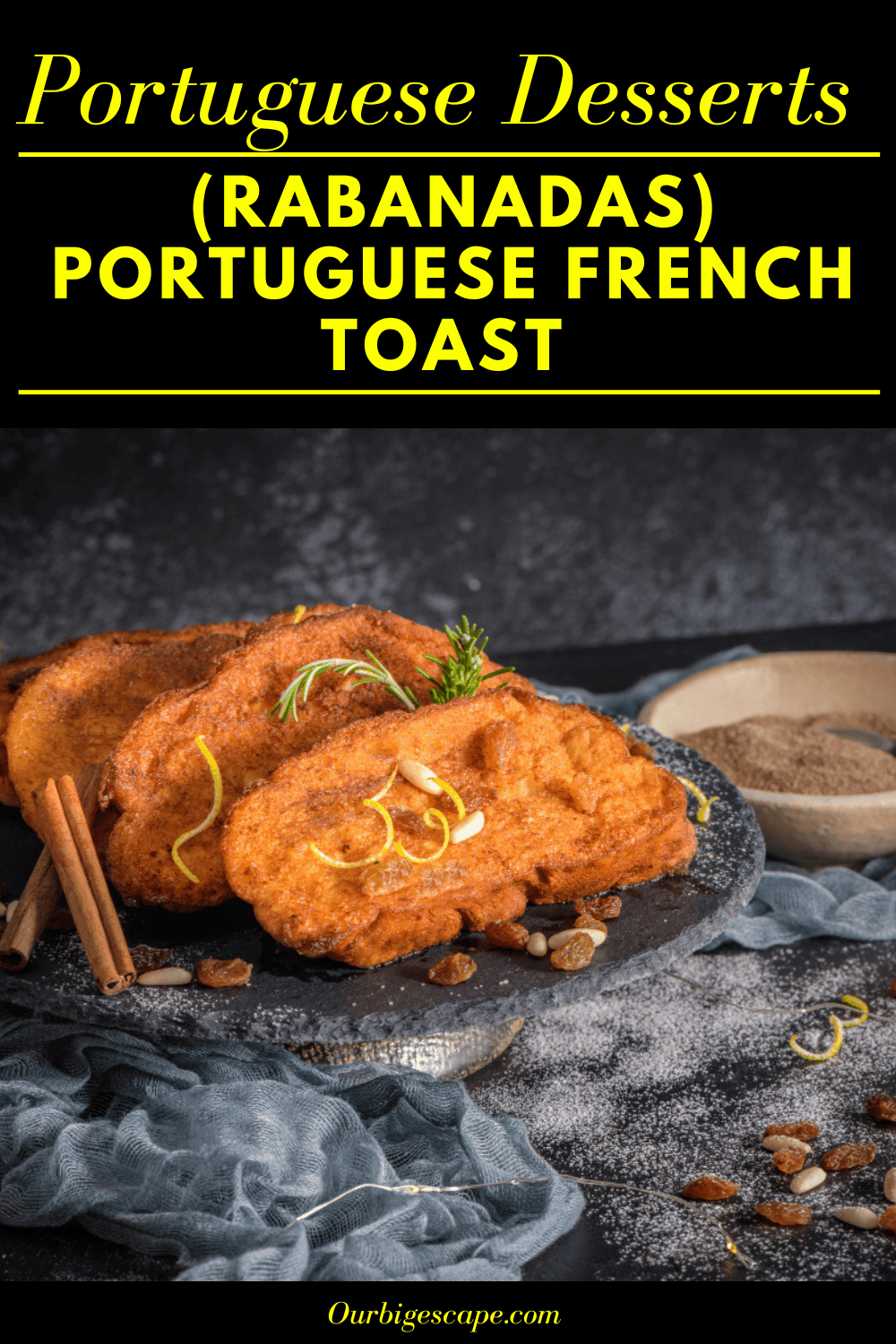Rabandas is one of our favorite Portuguese Recipes for Desserts. It translates to Portuguese French Toast. Easy to create and heavenly to eat. Portuguese French Toast (rabanadas) is a dessert or afternoon snack soaked in flavored milk, coated in beaten eggs, fried, and sprinkled with sugar-cinnamon. It is custardy inside and crunchy outside.
Brief History of Rabanadas
Rabanadas were first made many years ago during the Catholic holiday of Lent. Since many Portuguese Catholics stopped eating meat, they ate more bread. So, Rabanadas were made as a way to save and use all of the bread, whether it was fresh or stale.
You might think that French toast and Rabanadas are too similar to be true. In fact, Rabanadas are also called “Portuguese French toast” by some people. Google says that both of these sweet toasts appeared around the same time in history, between the fifteenth and sixteenth centuries.
If you want to give the dish some crunch, nuts are a great choice. Walnuts and/or hazelnuts are what I think work best. The bread is important. You want it to be stale. The staler, the better because it’ll be able to soak up more of that milk mixture without dissolving.
People in Portugal don’t eat these beautiful golden fried bread slices for breakfast. Instead, they eat them for dessert or as a snack in the afternoon. Rabanadas are mostly considered Portuguese recipes for desserts.
In a few ways, Portuguese fried bread is different from the French toast we’re used to in the U.S. Even though the same eggs, milk, and bread are used. The way they are made and cooked is different.
Instead of cooking Rabanadas in a little bit of butter, you fry it in olive oil until it turns golden brown. Then, you put cinnamon sugar on the fried bread to make the outside sweet and crunchy.
What is Rabanadas?
Rabanada (pronounced hah-bah-nah-duh; plural: rabanadas) is a type of French toast made with stale French baguette that is soaked in a mixture of milk, vanilla, and sugar, then dipped in beaten eggs, deep-fried, and then covered in sugar and cinnamon.
Juan del Encina wrote in the 15th century, “…honey and lots of eggs to make rabanadas…” and said that it was a dish that helped women get better after giving birth.
Hernández de Maceras’s cookbook from 1607 and Francisco Martnez Motio’s “Arte de cocina, pastelera, vizcochera y conservara” are where the first recipes can be found (from 1611).
By the turn of the 20th century, Rabanada was a popular dish in Madrid’s taverns, where it was served with jugs of wine. In Spain, the dish is often served during the Lenten season, while in Portugal, it is more likely to be served at Christmas.
From Spain to Portugal, and then from Portugal to Brazil, which was once Portugal’s most important colony.

check out our video
How To Make Rabanadas (Portuguese French Toast)
Ingredients:
-
- 24 slices stale French baguette ¾ inch thick (about 1½ baguettes)
- 2 cups whole milk
- 1 tbsp pure vanilla extract
- ½ to ¾ cup granulated sugar
- 4 large eggs lightly beaten and homogeneous
- Olive Oil for frying
- ½ cup sugar
- 1 tbsp ground cinnamon
- Honey or maple syrup to serve with optional
Instructions:
-
- Line a large baking sheet with a double layer of paper towel. Set aside.
- Divide bread slices between 2 large, shallow baking dishes, arranging them in one single layer each.
- In a jar or pitcher, mix well the milk, vanilla, and sugar.
- Pour milk mixture over the bread slices, distributing the liquid evenly over all the slices. Let bread slices soak for about 20 minutes, allowing it to soak up as much of the milk mixture as possible.
- By hand, pick up each one of the milk-soaked bread slices (handling it gently) and dip it into the beaten eggs, coating both sides and allowing the excess to drip back into the egg bowl.
- In a large heavy skillet, heat about 2 inches of vegetable oil over medium-high until oil is hot enough that it sizzles. Place the bread into the hot oil, and cook until well-browned on one side, about 1 to 1-½ minutes.
- Flip the bread and cook until both sides are golden brown.
- Carefully transfer rabanadas to the sheet lined with paper towels. Repeat with remaining slices of bread, cooking several simultaneously if the skillet is large enough.
- In a medium bowl, mix sugar and cinnamon together. Dredge all sides of the bread slices into the mixture. Any excess cooked egg threads can be removed before dredging bread slices into the sugar cinnamon mixture.
- Portuguese French toast can be served either warm or at room temperature, by itself or drizzled with honey or maple syrup.
Tips:
-
- Most of the time, cinnamon sugar is sprinkled on Rabanadas, but honey or sugar syrup can also be used.
- This recipe works best with breads like brioche, but French bread also works well.
- So that the bread doesn’t fall apart after soaking up the liquids, it should be stale and dry.
Notes:
Cinnamon-sugar can be used to coat all sides of warm Rabanadas. Serve at room temperature or warm.
Rabanada vs French Toast
American French toast is similar to Rabanada, but it is not the same thing. How is that so?
To make Portuguese French toast, you need stale bread that is either round or oval and thickly cut.
Also, the way it’s made is different! First, bread slices are soaked in milk (or a mixture of milk and water) and then coated with beaten eggs. They are then fried in oil and sprinkled with a mixture of sugar and cinnamon.
On the other hand, American French toast is quickly soaked in a mixture of milk and eggs and then cooked in butter that is sizzling hot.
End Results? The inside of Portuguese French toast is more like custard, and the outside is crunchier and sweeter than American French toast.
Because it is so sweet, it may be served as a dessert or as a snack in the afternoon instead of for breakfast. If you’ve never done this before, now is the time!
Milk, sugar, cinnamon, eggs, and oil can be found pretty much everywhere in the world. So can a French baguette or another round or oval bread.
Modernizing Rabanadas
Even though bolo rei and Rabanadas are the most famous Portuguese Christmas desserts, they are now eaten at other times of the year as well. Some modern Portuguese restaurants have been serving Rabanadas, which are similar to French toast or pain perdu but are made in a more sophisticated way, in new ways.
Normal Rabanadas are made of thick slices of country-style bread that have been soaked in milk and egg, then fried and covered with cinnamon sugar. In newer versions, things like custard, different sauces, and different breads and cuts are added.
The simple Rabanada has caused a real revolution in modern Portuguese food, and we think it’s about time we could eat this dessert, which is also called “golden slice” (fatias douradas), at other times of the year than Christmas.
Other common Christmas desserts, besides Rabanadaas, include aletria, which is made with milk and angel hair pasta, mexidos or formigos, which is a scrambled dish made with bread, nuts, honey, Port wine, and raisins, lampreia de fios de ovos, which looks like a lamprey and is made of syrupy egg threads, and sweet dough fritters like sonhos, azevias, coscores, and filhós.
Some of these may be on restaurant menus during the holiday season, while bolo rei, bolo rainha, and Christmas fritters are sold in almost every pastelaria in the country.
But in general, most of them are made at home by families and eaten there. If you go to Portugal around Christmas, we hope you’re lucky enough to be invited to someone’s house and get to see the sweetest side of Portuguese culture behind closed doors.
You May Also Like: 25 Of the Best Traditional Portuguese Recipes
Rabanadas - Portuguese French Toast
Ingredients
Equipment
Method
- Line a large baking sheet with a double layer of paper towel. Set aside.
- Divide bread slices between 2 large, shallow baking dishes, arranging them in one single layer each.
- In a jar or pitcher, mix well the milk, vanilla, and sugar.
- Pour milk mixture over the bread slices, distributing the liquid evenly over all the slices. Let bread slices soak for about 20 minutes, allowing it to soak up as much of the milk mixture as possible.
- By hand, pick up each one of the milk-soaked bread slices (handling it gently) and dip it into the beaten eggs, coating both sides and allowing the excess to drip back into the egg bowl.
- In a large heavy skillet, heat about 2 inches of vegetable oil over medium-high until oil is hot enough that it sizzles. Place the bread into the hot oil, and cook until well-browned on one side, about 1 to 1-½ minutes.
- Flip the bread and cook until both sides are golden brown.
- Carefully transfer rabanadas to the sheet lined with paper towels. Repeat with remaining slices of bread, cooking several simultaneously if the skillet is large enough.
- In a medium bowl, mix sugar and cinnamon together. Dredge all sides of the bread slices into the mixture. Any excess cooked egg threads can be removed before dredging bread slices into the sugar cinnamon mixture.
- Portuguese French toast can be served either warm or at room temperature, by itself or drizzled with honey or maple syrup.
Video
Notes
You May Want to Join Our Boondocking Group on Facebook For More Information
You May Want to Join Our Campfire Recipes Group on Facebook For More Information


